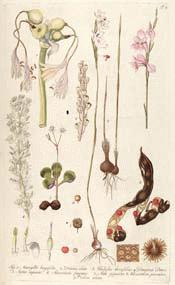
Botanical.com Home Page

|
Dragontree
(Dracaena draco)
Click on graphic for larger image
|
Dragon's Blood
Botanical: Daemomorops draco (BLUME)
Family: N.O. Palmaceae
---Synonyms---Calamus Draco. Draconis Resina. Sanguis draconis. Dragon's Blood Palm. Blume.
---Part Used---The resinous exudation of the fruits.
---Habitat---Sumatra.
---Description---Dragon's Blood, as known in commerce, has several origins, the substance so named being contributed by widely differing species. Probably the best known is that from Sumatra. Daemomorops Draco formerly known as Calamus Draco, was transferred with many others of the species to Daemomorops, the chief distinguishing mark being the placing of the flowers along the branches instead of their being gathered into catkins, as in those remaining under Calamus.
The long, slender stems of the genus are flexible, and the older trees develop climbing propensities. The leaves have prickly stalks which often grow into long tails and the bark is provided with many hundreds of flattened spines. The berries are about the size of a cherry, and pointed. When ripe they are covered with a reddish, resinous substance which is separated in several ways, the most satisfactory being by steaming, or by shaking or rubbing in coarse, canvas bags. An inferior kind is obtained by boiling the fruits to obtain a decoction after they have undergone the second process. The product may come to market in beads, joined as if forming a necklace, and covered with leaves (Tear Dragon's Blood), or in small, round sticks about 18 inches long, packed in leaves and strips of cane. Other varieties are found in irregular lumps, or in a reddish powder. They are known as lump, stick, reed, tear, or saucer Dragon's Blood.
---Uses---It is used as a colouring matter for varnishes, tooth-pastes, tinctures, plasters, for dyeing horn to imitate tortoiseshell, etc. It is very brittle, and breaks with an irregular, resinous fracture, is bright red and glossy inside, and darker red sometimes powdered with crimson, externally. Small, thin pieces are transparent.
---Constituents---Several analyses of Dragon's Blood have been made with the following results:
(1) 50 to 70 per cent resinous compound of benzoic and benzoyl-acetic acid, with dracoresinotannol, and also dracon alban and dracoresene.
(2) 56.8 per cent of red resin compounded of the first three mentioned above, 2.5 per cent of the white, amorphous dracoalban, 13.58 of the yellow, resinous dracoresene, 18.4 vegetable debris, and 8.3 per cent. ash.
(3) 90.7 per cent of red resin, draconin, 2.0 of fixed oil, 3.0 of benzoic acid, 1.6 of calcium oxalate, and 3.7 of calcium phosphate.
(4) 2.5 per cent of draco-alban, 13.58 of draco resen, 56.86 of draco resin, benzoic dracoresinotannol ester and benzoylaceticdracoresinotannol ester, with 18.4 of insoluble substances.
Dragon's Blood is not acted upon by water, but most of it is soluble in alcohol. It fuses by heat. The solution will stain marble a deep red, penetrating in proportion to the heat of the stone.
[Top]
---Medicinal Action and Uses---Doses of 10 to 30 grains were formerly given as an astringent in diarrhoea, etc., but officially it is never at present used internally, being regarded as inert.
The following treatment is said to have cured cases of severe syphilis. Mix 2 drachms of Dragon's Blood, 2 drachms of colocynth, 1/2 oz. of gamboge in a mortar, and add 3 gills of boiling water. Stir for an hour, while keeping hot. Allow to cool, and add while stirring a mixture of 2 OZ. each of sweet spirits of nitre and copaiba balsam.
---Dosage---1/2 oz. for catharsis, followed by 1 drachm two or three times a day.
---Other Species---
The Malay varieties are from D. didynophyllos, D. micranthus and D. propinguus.
The Borneo variety is from D. draconcellus and others. 'Zanzibar Drop' or Socotrine Dragon's Blood is imported from Bombay and Zanzibar, and is the product of D. cinnabari. It has no scales, and like other nonSumatra varieties, is not soluble in benzene and carbon disulphide.
Dracaena Draco is a giant tree of the East Indies and Canary Islands, and shares with the baobab tree the distinction of being the oldest living representative of the vegetable kingdom, being much reverenced by the Guanches of the Canaries, who use its product for embalming in the fashion of the Egyptians.
The trunk cracks and emits a red resin used as 'tear' Dragon's Blood, now rarely seen in commerce.
Dracaena terminalis, or Chinese Colli, yields Chinese Dragon's Blood, used in China for its famous red varnish. In some countries a syrup, yielding sugar, is made from the roots (called Tii roots). An intoxicating drink can be made from it, and it has also been used in dysentery and diarrhoea, and as a diaphoretic.
Pterocarpus Draco, of the East Indies and South America, yields a resin found, as Guadaloupe Dragon's Blood, in small irregular lumps.
Croton Draco or Mexican Dragon's Blood, is called Sangre del Drago, and is used in Mexico as a vulnerary and astringent. Others used are from:
Croton hibiscifolius of New Granada.
Croton sanguifolius of New Andalusia, and
Calamus rotang of the East Indies and Spanish America.
See SEDGE (SWEET).
[Top]
Common Name Index
A MODERN HERBAL Home Page
Bear in mind "A Modern Herbal" was written with the conventional wisdom of the early 1900's. This should be taken into account as some of the information may now be considered inaccurate, or not in accordance with modern medicine.
© Copyright Protected 1995-2025 Botanical.com
|

